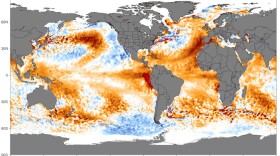-
Hundreds of miles west of Oregon, the Axial Seamount appears to be heading to another eruption.
-
A recent report out of Oregon State University paints a picture of how ocean oxygen levels have decreased in the Pacific Northwest over the years.
-
During the summer of 2021, half of coastal waters from northern California to the Canadian border had oxygen levels too low to support marine life.
-
Tidal wetlands trap a lot of carbon dioxide. A recent survey maps those marine carbon sinks, also called “blue carbon” ecosystems, on the Southern Oregon coast.
-
The sudden mussel die-off seems to be happening mostly along the Pacific Northwest coast.
-
While the world’s oceans have been hitting record temperatures in 2023, Northwest coastal waters have, until recent weeks, remained cooler than their long-term average. Now the Pacific Northwest has joined the rest of the world in having exceptional ocean heat.
-
Temperatures in the world's oceans surged to new levels in April, nearing an average of 70 degrees Fahrenheit for the first time on record, according to the University of Maine’s Climate Change Institute.
-
The winners of the first offshore wind auction on the West Coast were announced Wednesday. The auction netted over $750 million dollars after two days of bidding.
-
After erosion brought the ocean more than 100 feet closer to the Pine Beach neighborhood over the last 30 years, homeowners built barriers known as rip rap. Environmentalists say Tillamook County is tossing out years of land-use precedent by allowing the erosion controls. Residents say they followed all the rules.
-
Highway 101, the backbone of Oregon’s coastal transportation system, is in a sorry state. In several spots, tarmac is crumbling into the ocean. But the state is having trouble repairing it because doing so runs contrary to Oregon’s powerful land-use rules. So now, authorities want to tweak the rules despite the failure of past efforts.
-
The National Oceanic and Atmospheric Administration will be joining an international expedition this week to better understand salmon during the winter and how climate change is affecting their life cycle.
-
Sunflower sea stars, a large 24 armed marine predator that lives on the West Coast, are one step closer to receiving protections under the Endangered Species Act.
-
Scientists don’t know why some types of sea stars are returning to Oregon while others were hit so hard by disease they’re critically endangered. Continued research at places like Cape Blanco on Oregon’s south coast could provide insights.
-
Where once there were forests of kelp in the ocean, there is only water. And sea urchins. A combination of warm water and other ocean conditions battered…















